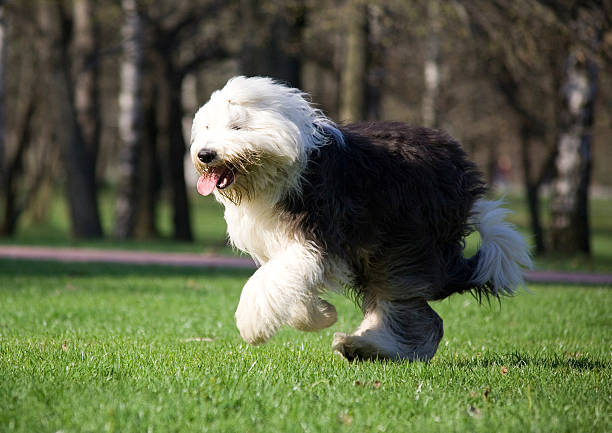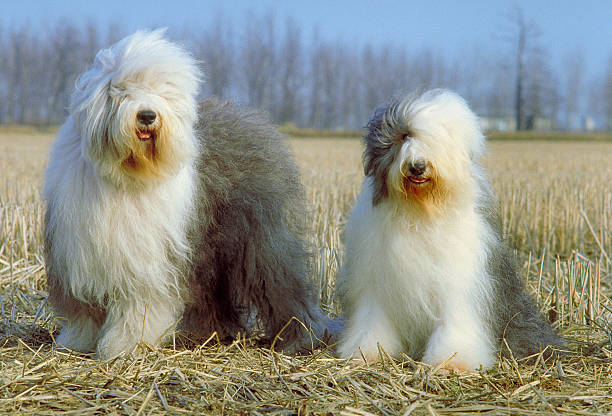Old English Sheepdog

Breed History:
The Old English Sheepdog (OES) originated in England during the early 19th century as a drover’s dog, used to herd cattle and sheep to market. Contrary to its name, it does not directly descend from ancient British sheepdogs but was likely developed from crosses between Bearded Collies and various European herding dogs.
Farmers prized the breed for its stamina, weather-resistant coat, and driving instinct. Its bobbed tail—often docked to signify working status and avoid taxes—led to the nickname “bobtail.” Over time, the OES evolved from a hardworking farm dog to a beloved show and companion breed, known for its distinctive appearance and cheerful demeanour.
|
Gender |
Height |
Weight |
|
Male |
61 cm |
32-45 kg |
|
Female |
56 cm |
27-36 kg |
Size – Large
Life Expectancy:10–12 years

Breed Appearance:
The Old English Sheepdog is a large, square-built, muscular dog with a profuse, shaggy coat that covers its body, including its eyes. The double coat is thick, with a soft undercoat and a harsh, textured outer coat, and comes in grey, blue, or blue merle with white markings.
It has a large head, dark or blue eyes, and small, pendant ears. The body is compact and strong, with a distinctive rolling gait. Despite its fluffy appearance, the OES is a powerful and agile mover, bred for endurance in rough terrain.
Breed Type – Herding/Companion:
Originally a working herding dog, the OES has become an affectionate and family-oriented companion. It is known for its gentle nature, clownish behaviour, and deep loyalty to its people.
This breed is protective without being aggressive, making it a good choice for families with children. It may try to herd people or animals due to its herding instincts, especially in play.

Training:
Intelligent and eager to please, the OES is generally trainable, though some individuals may have a stubborn streak. Consistent, positive training with praise and treats works best.
Early socialisation and obedience training are essential to manage its size and energy. The breed does well in agility, obedience, and even herding trials, when properly motivated.
Health & Care:
The Old English Sheepdog is generally healthy, but like many large breeds, may be prone to:
-
Hip dysplasia
-
Cataracts and progressive retinal atrophy (PRA)
-
Hypothyroidism
-
Deafness (can occur in some lines)
-
Bloat (gastric torsion)
Routine check-ups, genetic testing from reputable breeders, and proper nutrition are key to a long and healthy life.

Living Conditions:
The OES can adapt to various living environments but needs space to move around. A home with a yard is ideal, but one can live in an apartment if given ample daily exercise.
It prefers to be near its family and may develop separation anxiety if left alone for long periods. It tolerates cold weather well but may overheat in warmer climates due to its thick coat.
Exercise:
Moderate to high energy, the OES requires daily physical and mental activity. 60–90 minutes of walking, running, or playtime is ideal. It enjoys games, training sessions, and even herding or agility work.
Without enough activity, it may become bored, bark excessively, or develop undesirable behaviours.
Grooming:
Grooming the OES is a major commitment. Its coat requires thorough brushing 3–4 times per week, or even daily, to prevent matting and debris build-up. Many pet owners opt for professional grooming or shorter “puppy cuts” to manage maintenance.
Regular bathing, ear cleaning, nail trimming, and dental care are also essential. Shedding is moderate, but grooming is time-intensive due to the coat’s length and density.

Advantages:
-
Loyal, affectionate, and great with children
-
Intelligent and capable of learning complex tasks
-
Distinctive appearance with a soft, cuddly look
-
Excellent family companion and watchdog
-
Adaptable to active or moderately active households
-
Fun-loving and playful with a gentle temperament
Disadvantages:
-
Requires extensive grooming and coat care
-
May herd or nip without proper training
-
Prone to hip and eye conditions
-
Not ideal for hot climates due to the heavy coat
-
Can be stubborn and independent-minded
-
Needs regular exercise to prevent boredom-related issues







